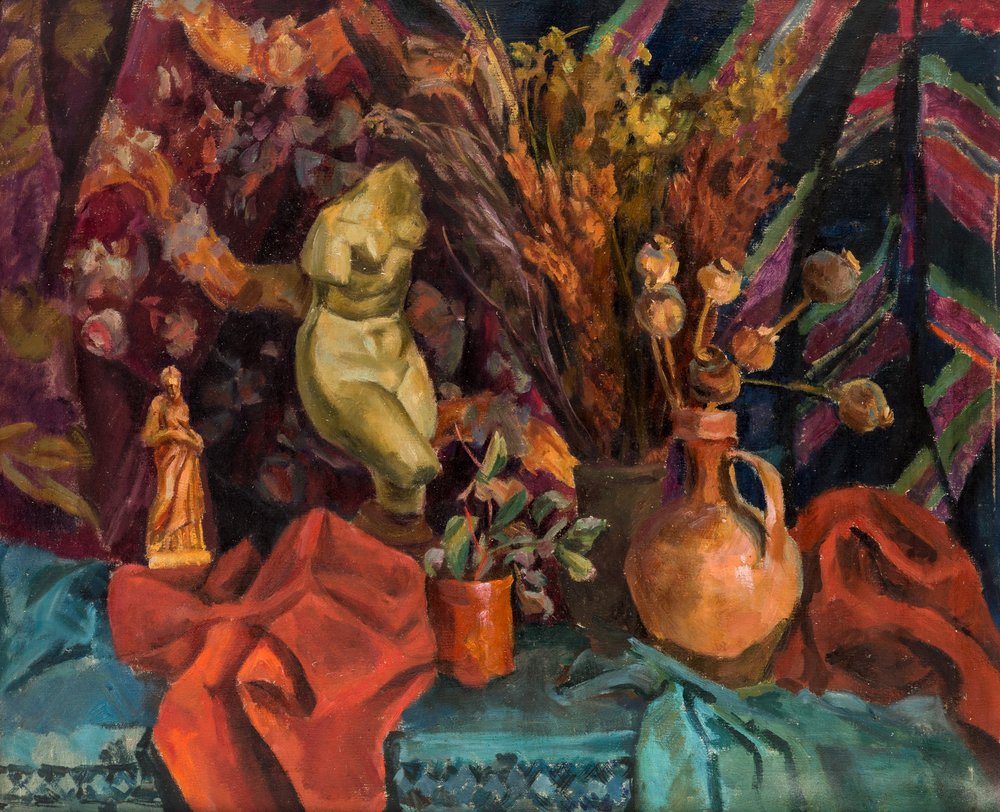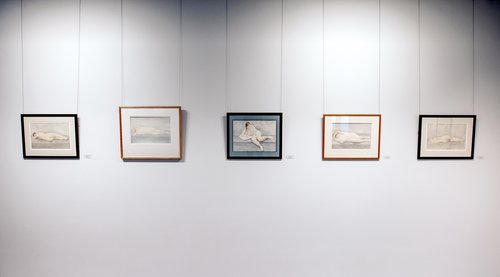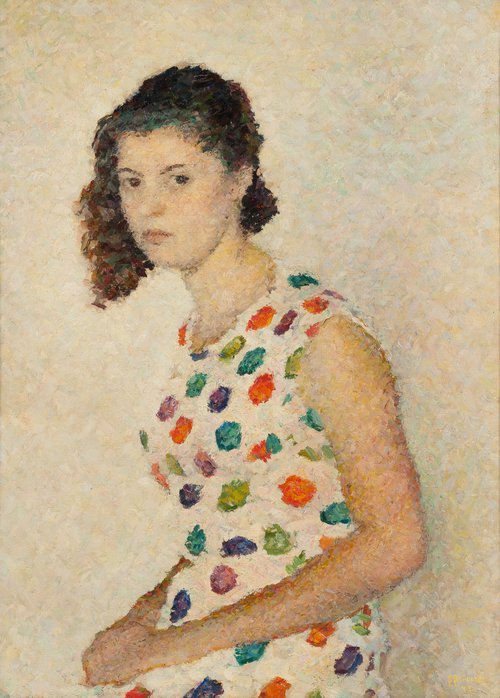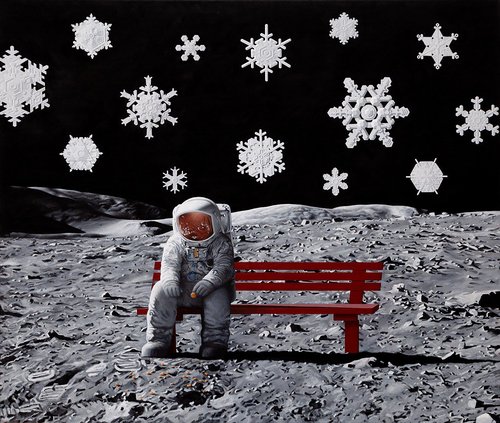Osmerkin’s Journey: Art, Tragedy, Influence, and Enduring Legacy

Alexander Osmerkin. Still life with the torso of Venus, 1951. Collection of Inna Bazhenova. Courtesy of In Artibus Foundation
The exhibition ‘Continuous Artist: The Paintings of Alexander Osmerkin,’ curated by Elena Rudenko and hosted by In Artibus Foundation, spotlights the artist´s late works as well as his enduring influence, shedding light on his unique artistic journey amid turbulent historical times.
In 2021, Russian television broadcast the series ‘Vertinsky,’ directed by Avdotya Smirnova. This series offers a rather loose interpretation of the biography of the celebrated 20th century Russian cabaret singer. The opening scenes of the first episode are set in the mid-1910s, where the main character is partying with friends, including the young artist Alexander Osmerkin (1892–1953), who appears again in the final episode. Alexander Vertinsky returns to his homeland after twenty-five years of exile. In the Soviet Union, he reunites with Osmerkin, who tells the singer’s wife, Lidia, to enrol in an art school and later at the Moscow Institute of Fine Arts, where Osmerkin taught. One scene mentions that Osmerkin himself had fallen out of favour, was accused of formalism and kowtowing to the West, resulting in his removal from leadership positions at the Repin Institute in Leningrad and the loss of his workshop at the Surikov Art Institute. Like a comet soaring too close to the sun, Osmerkin dramatically exits the storyline.
Osmerkin is hardly a prominent figure among artists of the first half of the 20th century. His rare appearance in the Vertinsky series only serves as an exception that proves the rule. Even in this TV soap opera, he appears in just two ‘chapters’, seemingly by accident. It seems the artist’s presence in the script was left by mistake and not cut during final editing. Nevertheless, Osmerkin’s life story is itself far from uninteresting. On the contrary, it deserves its own biopic, even though he has never been a favourite artist among art historians as so many of his contemporaries have.
The exhibition ‘Continuous Artist: The Paintings of Alexander Osmerkin’ at the In Artibus Foundation and curated by Elena Rudenko can hardly be called biographical in the strictest sense. It focuses solely on the artist’s late work and somewhat on his posthumous influence on other painters. The 1940s and until he died in 1953 was an eventful period in Osmerkin´s life most suited to a film adaptation. By this time, the avant-garde experiments and fierce artistic disputes of previous decades had long since faded; there were no personal and professional encounters with the powerful figures of the 1910s and 1920s, nor the revolutionary epoch’s tumultuous backdrop. Yet, Osmerkin underwent an almost classical tragedy during and after World War II. His story follows a widely archetypal trajectory: a rapid ascent to fame and power (in the widest sense), sudden loss of everything followed by severe retributions. In Russia, this rags-to-riches-and-back narrative has become commonplace and remains relevant today.
Despite his roots in the avant-garde, during the 1930s, Osmerkin’s career and influence began to soar. And by the beginning of the next decade, he had already become well established, with a seemingly solid position in the academic world and considerable influence, until 1947. Now the blows fell on those who had survived the Great Terror of the late 1930s, survived all previous purges and anti-formalist campaigns. The general obscurantism of the late Stalinist era did not allow even the most notorious conformist masters to waver from the party line. Osmerkin could be quite careless and often said things that got him into trouble.
During the second half of the 1940s, the Cold War began. The sharp break between the Soviet Union and Western countries immediately affected all spheres of life. In addition to political and economic isolationism, the struggle against foreign influence erupted in culture. At this time Osmerkin was reminded that years ago, back in 1941, during the defence of his diploma at the All-Russian Academy of Arts, he had criticized the Russian school of painting and praised the French Impressionists, even specifically comparing Paul Cezanne (1839–1906) with Alexander Ivanov (1806–1858), to the detriment of the latter.
These dramatic events, although detailed in the curatorial text of the exhibition, do not dominate the display. The In Artibus exhibition contains a relatively modest collection of Osmerkin’s own works, complemented by paintings by his fellow Cézannists in the Jack of Diamonds group including Pyotr Konchalovsky (1876–1956), Ilya Mashkov (1881–1944), and Robert Falk (1886–1958). Also featured are works by Osmerkin’s pupils, such as Evsey Reshin (1916–1978) and Vladimir Weisberg (1924–1985), and their followers, including Boris Kasatkin (b. 1944), who are linked to Osmerkin through Weisberg. For instance, there are works by Porfiry Krylov (1902–1990), one of the Kukryniksy trio, whom Osmerkin taught at Vkhutemas in the 1920s.
Large wall spaces display texts including excerpts from Osmerkin’s own letters, and memories about the artists penned by fellow students and friends. Among these, one learns that Osmerkin loved working in Crimea, as “everything there is reminiscent of French painting” and “evokes memories of my old mentor Cézanne” (from a letter to his second wife Elena Galperina, 1938). Ten years later, during his fall from grace, he wrote: “I shall say of myself – I lived and developed as did my time; I only regret having given much of my time to others. Because of this, I did not become a careerist or an official, but remained, as in childhood, a painter. Perhaps I lack what it takes to be an artist. I am fifty-eight but, like a loyal soldier, I will stay with my brush as one must with a rifle.”
The human tragedy outlined in the foreword of the exhibition remains unspoken in the works of art themselves. Neither portraits, still lifes, nor landscapes reveal the artist’s personal turmoil. Even texts that might shed some light on the artist’s circumstances focus mostly on art. This creates an intriguing cinematic effect: knowing the context allows the viewer to imagine the hidden story behind the apparently detached paintings, perceiving them as a form of escapism. Whether this was truly the case is difficult to ascertain. In the end, Osmerkin once again soared like a comet and vanished into the distant cosmos.
Continuous Artist: The Paintings of Alexander Osmerkin
Moscow, Russia
19 September – 30 November, 2025


















